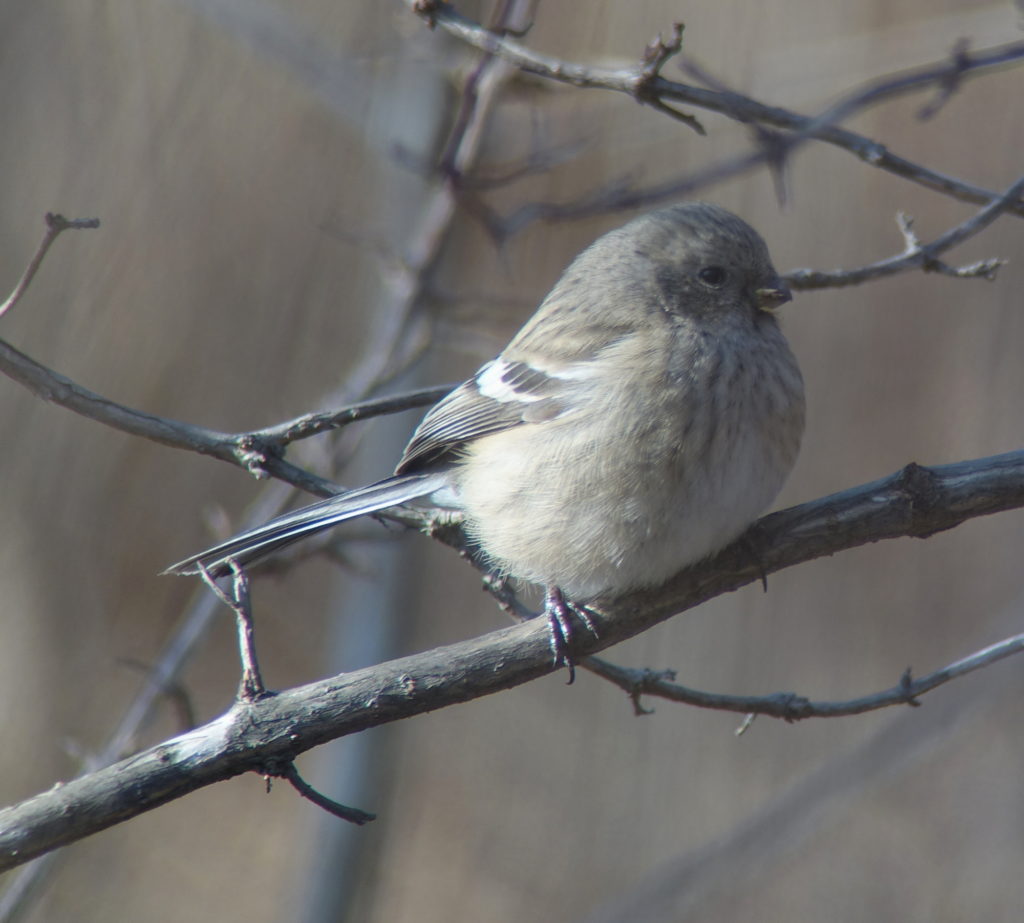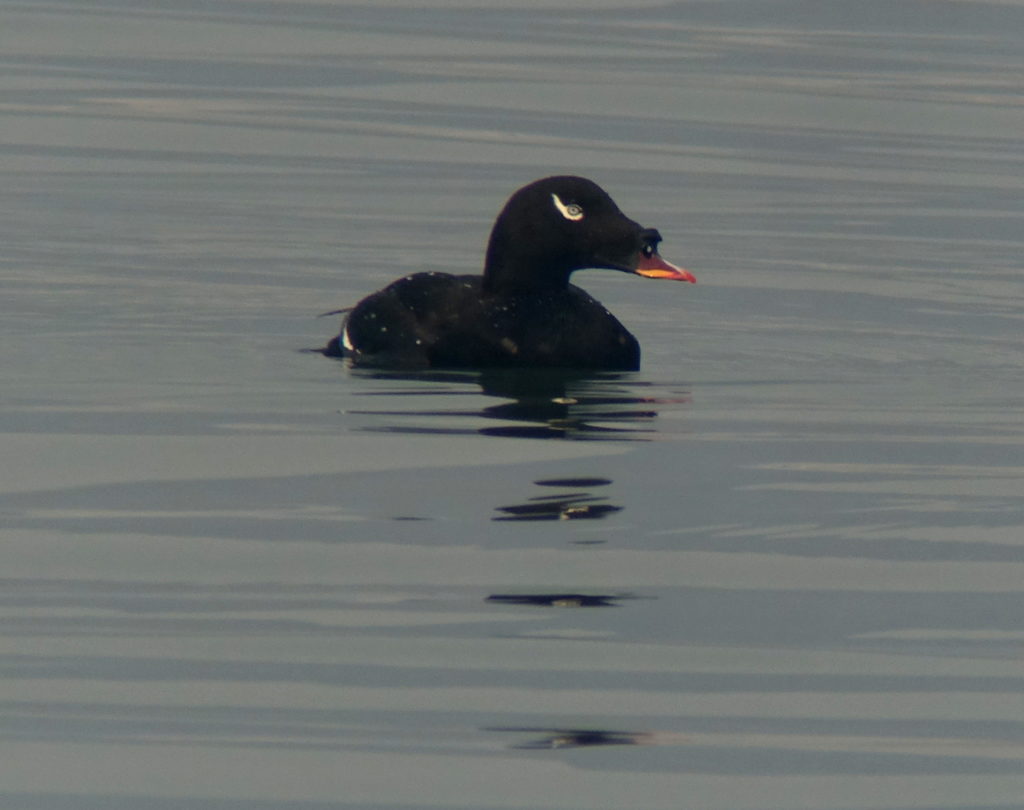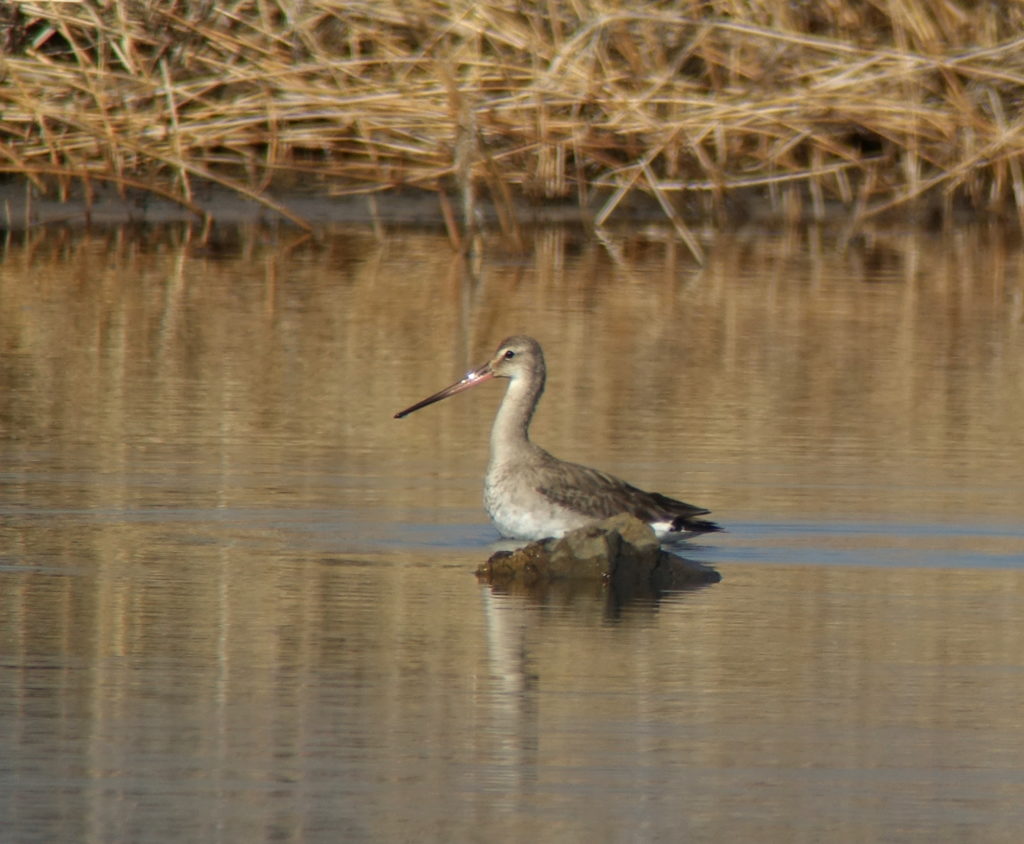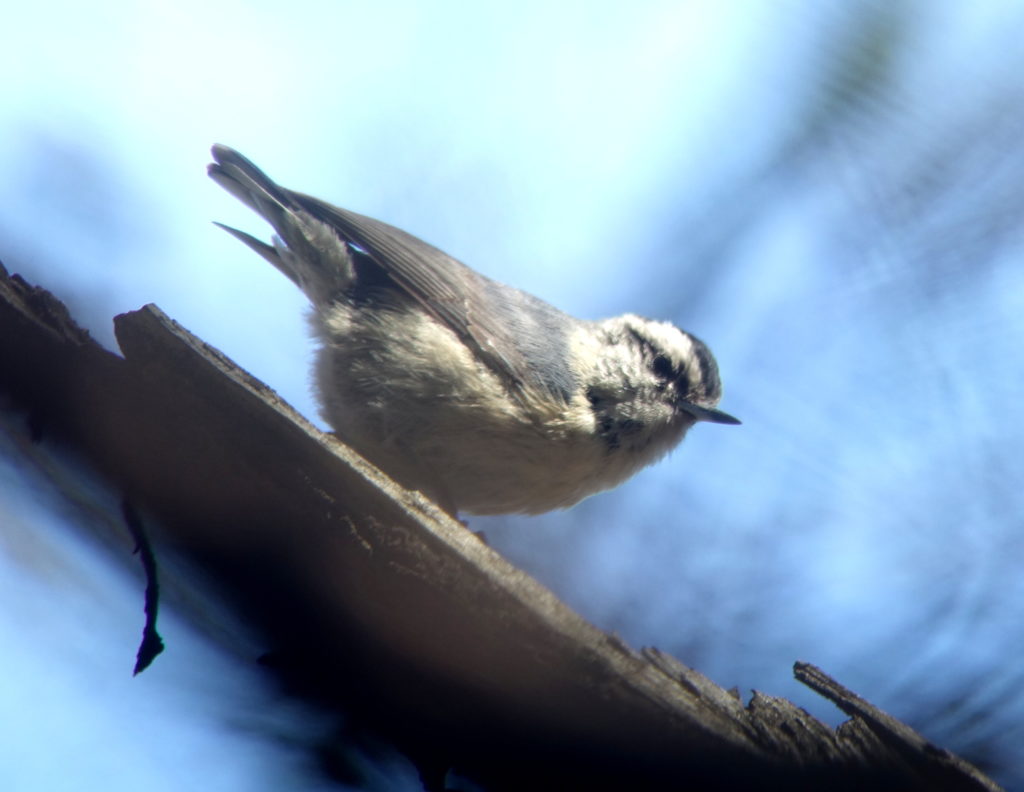Bird News from Nial Moores with Bernhard Seliger (Hanns Seidel Foundation, Korea office), Cheng Qian (UNESCAP) and Guo Jin, Han Yongxiang and Yang Ziyou (SBS in China, Shanghai) from March 15-19 & from March 21-26 Au Man Cheong, Chan Wai-Man, Ho Lai Ko Lego, Ku Wai Yi, Lam Chiu Ying, Lee Kam Cheong (Lee “KC”), Lee Wai Chu, Lee Yuk Ying, Sham Tin Lung, So Man Wan and Wong Tin Wa (all members of the Hong Kong Birdwatching Society).

In back-to-back birdwatching tours (the first largely funded by the Hanns Seidel Foundation, the second run more or less as if commercial), a total of 131-133 bird species and five mammal species were logged in Rason. Lots of turnover and visible migration was enjoyed most days, including a rapid build-up in duck numbers, high-flying flocks of Grey Heron and long skeins of geese crossing the bays and hills on their way north out of Korea and on into China and Russia.

© Nial Moores
En-route to Rason too, additional birding highlights in under an hour on the 15th in the now-famous wetlands in Hunchun (PR China) close to the border crossing included no less than six Steller’s Sea Eagle, 15 White-naped Crane and six Hooded Crane; and in two hours on 26th, still one adult Steller’s, an inland adult Glaucous Gull and likely the very same six Hooded Crane.
While a separate note outlining the rationale and explaining some of the logistics of “avitourism” to Rason will be posted later, this one details more simply some of the wildlife highlights we enjoyed. These included spectacular and close encounters with tens of thousands of duck and three species of swan on the freshwater Sobon lake (within Rason Ramsar site); Glaucous and Slaty-backed Gulls along the coast and on thawing lake ice; and from land, stunning views of both scoters, of Harlequin Duck, and of Long-tailed Duck as their plumages progressed from ice-white to tundra-brown; close views too of Spectacled Guillemot, Long-billed Murrelet and Ancient Murrelet; and more distant scope views of three species of loon and five species of grebe, many of which were coming into breeding plumage.


We also enjoyed a very good spread of land birds – many found during near-daily morning walks from our hotel – including three species of woodpecker, a single calling and singing Willow Tit, several Chinese Nuthatch, Eurasian Treecreeper, plentiful Long-tailed Rosefinch, a small group of Pallas’s Rosefinch and close to Sobonpo, two possible Jankowski’s Bunting.




© Lisa Guo
We also saw Siberian Roe Deer on several dates, including three together on the forest road behind our hotel, and once – in between snow showers – some of the group from Hong Kong even saw a stunning Korean Red Fox (first picked up by our local guide, Mr. Mun) leaping away through the dunes at Uam. My images (terrible and out of focus) would have been pretty good if I had not been so excited…after all this was my first live encounter in Korea of what is now generally considered to be a very rare species here.

In a little more detail (and in the expectation that better images will be added later!) some of our highlights included:
Brant Goose Branta bernicla. Bird of the trip for a couple of the participants as the species is now so rare in China (as it is also becoming in the ROK): four first seen on the 17th increasing to 12 by the 23rd.

Swan Goose Anser cygnoides. VU. One on 22nd.

Greater White-fronted Goose Anser albifrons. A coarse estimate of 1,200 were seen on active migration during the 12 days of observations, with several hundred of the same (or additional?) also staging on Sobon Lake and on Sonbong Wetland.

© Nial Moores Nial Moores
Lesser White-fronted Goose Anser erythropus. VU. Several times, obviously small white-fronts were seen in among Greater White-fronted Geese flocks, including one within a group of 30 Greater Whitefronts on 25th which was very likely this species and one photographed in among a mixed group of grey geese on March 16th.

Mute Swan Cygnus olor. Probably 100 were present on Sobon Lake (similar to the 106 counted in Rason in March 2014, but only half the number estimated here by Bernhard Seliger and Amael Borzee in March 2018). Either way, the largest concentration of this species in Korea so far this year. Of particular note, one of those seen on March 18th carried a neck band, which thanks to some quick reactions and skillful camera work by Yang Ziyou can be identified as “2T07”. Following correspondence on Facebook with Batmunkh Davaasuren (on April 10th) we can confirm that this bird was banded at Buir Lake Ramsar site in Mongolia on July 31st 2018 by a team from the WSCC. This was the same Mongolian lake where Mute Swan seen in northern Gangwon Province in November 2017 were also banded.


Tundra Swan Cygnus columbianus. A minimum 90 were present on Sobon Lake. This appears to be a larger count than any given for the DPRK in Tomek (1999), and exceeds the total recorded nationwide each year since 2007 in the ROK during the annual MOE Winter Census (with e.g. only 28 recorded nationwide in January 2017).

Whooper Swan Cygnus cygnus. About 1,000 were estimated to be on Manpo and Sobonpo on March 16th; with many seen departing on several dates, but still probably 900 present on 25th.

Baikal Teal Sibirionetta formosa. The trip highlight for one of the participants from Hong Kong, who shared with us that she had waited 20 years for this, her very first view of this species. Only recorded on two dates: 70 on March 18th and 22 on March 25th.
Falcated Duck Mareca falcata. Good numbers were first encountered on the 18th, and a conservative 1,200 were present on 25th. The number might have increased further after we left, as previous surveys found 3,100 here between March 25th and 30th 2014; and 2,052 between March 24th and 27th 2018.
Eurasian Wigeon Mareca penelope. Easily the most abundant bird of the trip – increasing rapidly from 3,500 on 16th to a conservative 15,000 on 25th! Despite a decent time spent searching, we sadly failed to find any American Wigeon mixed in, though we did locate 2-3 Eurasian x American hybrids.
Common Pochard Aythya ferina. VU. Few seen, until a raft of c. 3,000 were found at the northern end of Sobonpo on 25th.
Stejneger’s Scoter Melanitta deglandi stejnegeri. Stunning, “light through the nostril” views of this gorgeous duck were enjoyed on almost all dates. Although some stretches of coast were not surveyed this time, at least 900 in total were likely seen by the groups.

American Scoter Melanitta americana. NT. Widespread along the coast, with about 200 in total seen and heard crooning.

Long-tailed Duck Clangula hyemalis. VU. Probably at least 350 were seen, including 20-50 off from Pipa Islet most dates. One of my personal highlights this visit was having the time to observe the rapid head and body moult of these birds, transforming males from white to brown in only a couple of weeks.

Hooded Crane Grus monacha. VU. A group of ten overflew the forest by our hotel just after breakfast on 25th.
Horned Grebe Podiceps auritus . VU. At least 30 were recorded: likely the start of a slow build-up which peaked back in late April 2016 with a flock of 345 breeding plumaged birds…

Northern Lapwing Vanellus vanellus. NT. Small numbers seen on most dates, including some in rolling flight-display – this in spite of further habitat loss and degradation at the southern end of Sobonpo.


Long-billed Plover Charadrius placidus. Three in the Sonbong Wetland on 16th and one in the degraded fish/ crab ponds in Sobonpo on 25th.

Black-tailed Godwit Limosa limosa. NT. One in Soponpo on 25th was highly unexpected. This species typically arrives in Korea during northward migration in early May, much later than e.g. Bar-tailed Godwit, and surviving a Rason winter – even one that was atypically mild like the one just passed – would be impossible. Considering the exceptional date, how (un)likely is it that this might even have been the very same individual that spent the winter at Junam Reservoir, 800km to the south-southwest?

Glaucous Gull Larus hyperboreus. Another trip highlight – with multiple encounters, including 35 in a single scan and one hybrid.


Relict Gull Ichthyaetus relictus. VU. At least four individuals seen, though none in the formerly favored area of Dongbonpo.
Spectacled Guillemot Cephhus carbo. Although apparently not yet recorded in China (at closest only 27km away!), we enjoyed near-daily encounters with this species.


Long-billed Murrelet Brachyramphus perdix. NT. Seen twice from Pipa, before a spell of more windy weather: two on 16th and one on 19th.

Ancient Murrelet Synthliboramphus antiquus. Seen in small numbers at several points along the coast, with 13 on the 16th the highest day count.

Hill Pigeon Columba rupestris. Seen in only two areas, with 24 the highest day count.
Chinese Grey Shrike Lanius sphenocercus. Singles found in five different area.

Willow Tit Poecile montanus. Always a challenge to pick out from the much more numerous Marsh Tits, one obliging bird during the calm and mild morning of the 17th gave several diagnostic scalding calls before breaking into song.
Long-tailed Tit Aegithalos caudatus. Although “northern” white-headed birds were seen multiple times, much more surprising was glimpsing a single “southern” bird with dark head-stripes, apparently teamed up with a white-headed bird, on the 20th. Although no images were taken, views were considered sufficient to rule out the extralimital Silver-throated Tit.

Chinese Nuthatch Sitta villosa. Several singing males were present – and were occasionally even visible! – in the forest around our hotel.

Common Starling Sturnus vulgaris. One was seen and very poorly (in truth, horribly!) digiscoped during heavy snow and sleet in rice-fields next to the Sonbong wetland on 21st. The bird was not re-found later, despite some searching by the group after the weather had improved. Although there are a couple of sight records, we are not aware of any photographic documentation of this species in the DPRK since one was collected there in 1977.

Chinese Blackbird Turdus mandarinus. A long-tailed, blackish-brown thrush was seen briefly flying downslope into cover. Although the obvious default ID is Chinese Blackbird, inclusion here is somewhat tentative, as this would be the first record we are aware of for Rason and for the DPRK away from the southwest.
Asian Rosyfinch Leucosticte arctoa. One was at Uam on March 17th.

Pallas’s Rosefinch Carpodacus roseus. A group of five, including a stunning male, were on Sanghyansan on March 17th. Snow on 21st and 22nd made the road up the mountain un-drivable – so that only one more was heard during the trip (and that by me alone) on 24th.
Jankowski’s Bunting Emberiza jankowskii. EN. On 18th, walking through an extensive area of dry reed interspersed with arable fields on the eastern side of Sobonpo, we came across a group of 20-25 buntings. Most of these were clearly Meadow and Pallas’s Reed – the latter species one we were aiming to get good views of. However, as one female meadow-type bunting sat up briefly, she looked really quite pale below, almost whiteish on the belly; and looked, as the sun caught her head, to have greyish tones to the ear coverts. Female Jankowski’s? Surely not. Although this part of Rason was at worst within only a few km of where Jankowski’s were collected almost a century ago, we had failed to find them in several survey visits, and this really was not the dune-like habitat that we had convinced ourselves should provide the best chance of finding the species. As many birders do, I therefore tried to convince myself that I had not seen the bird properly; that it must have been a Meadow; but all the same wanted everyone to try to get another look, and to photograph every bunting just in case. After 15-20 tense minutes of trying to check through the same increasingly flighty and loose group of birds, two male buntings sat up again briefly, half-against the sun. One was clearly an adult male Meadow: dark chestnut ear coverts; rich tones below; lots of saturation above. The other bird was obviously paler and duller, and the head pattern looked “off” for Meadow, more contrasting than expected, with dull, darkish, perhaps brownish-grey ear coverts topping a quite extensive area of white and dark. Side on, the bird looked pale below, but did not appear to have anything resembling the much hoped-for belly patch. Strikingly, however, he showed two distinctive, white or whitish wing-bars – much stronger than any I have noticed on Meadow before – and generally considered one of the diagnostic ID features of Jankowski’s. As I reached for my camera, both birds flew, and the whole flock continued to disperse over an ever wider area, perhaps without anyone but myself yet seeing either of the birds through optics (?). The wind was picking up and the challenge to re-find either of these birds seemed to increase by the minute. We stopped for lunch and one of the group decided that we should leave: perhaps a sensible course of action all things considered. A return visit with the Hong Kong birders was keenly anticipated – but a combination of winds most days and an un-driveable track following a day of snow prevented us from trying again.
Ochre-rumped Bunting Emberiza yessoensis. At least nine were found in total, with some evidence of birds arriving during the 12 days. Unfortunately, as in previous years, many of the preferred areas of sedge used by breeding birds had again been burnt over during the winter – one of many management issues within the recently-designated Ramsar site.

Clearly, Rason is one of the most important areas for biodiversity on the Korean Peninsula. The birding is spectacular, but there are (major) threats to many of the habitats – including the construction of fish ponds and now even a sea-cucumber factory in the wetland; reed burning; and a slow but steady increase in use of plastics in the countryside.
In the next post we will try to explain more about the rationale and potential of birdwatching-based ecotourism as a way of opening minds and hearts and trying to progress towards genuinely wise and sustainable use of Rason’s natural resources. We welcome your thoughts and comments, either direct to the blog (which sometimes does not register comments well) or to the Birds Korea Facebook page.


© Lisa Guo; and being wowed by flocks of ducks, geese and swans
© Yang Ziyou

